How would you like to see a star drop two magnitudes in the time it takes to eat dinner? Easy to do. Just check out one of these fast eclipsing binaries — they’ll make your head spin.
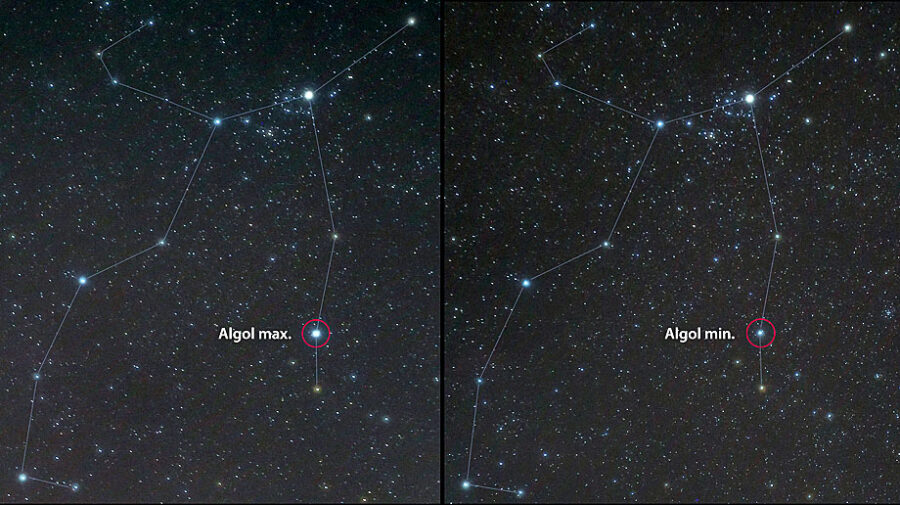
Bob King
Algol the "Demon Star" is the most familiar eclipsing binary in the night sky. Normally it's a steady light at magnitude 2.1, but every 2.86 days (2 days, 20 hours, and 49 minutes) the fainter star in the pair passes in front of the brighter, and the system dims to magnitude 3.4. The difference is very obvious to the eye. A full eclipse lasts 10 hours but you can watch the steepest part of the decline to minimum or rise toward maximum in just a few hours.
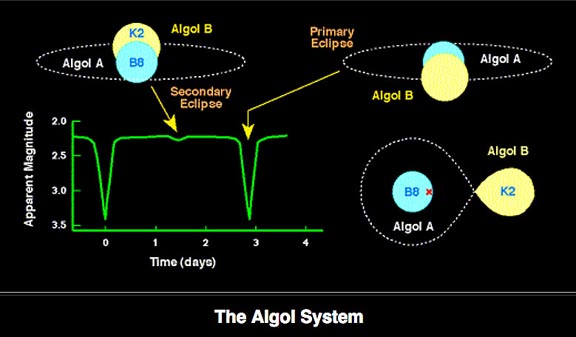
Mike Guidry (University of Tennessee)
In an eclipsing binary (EB) system two stars circle about their common center of gravity. Because the stars' orbital plane is almost edge-on to Earth, they regularly eclipse one another. There are actually two eclipses: a primary eclipse when the fainter star blocks light from the brighter one, and a secondary eclipse when the brighter star passes in front of the fainter one. The stars are usually in such a tight orbit that they can only be resolved spectroscopically.

Merikanto / Wikipedia CC BY-SA 4.0
Some EBs dim to minimum and rebound to maximum more dramatically than Algol, fading and recovering in near-real time. These fast eclipses are exciting to watch, on par with tracking a fast-moving asteroid or witnessing the Moon occult a star. Many are bright enough to follow under light-polluted or moonlit skies — ideal conditions not required!
Earlier this month I had the pleasure of watching Z Draconis drop from magnitude 11.5 to 13.7 in just 45 minutes. Forty minutes later it was well on its way to recovery. When a binary undergoes a partial eclipse (when the star in front doesn't completely cover the star behind, just like in a partial solar eclipse), minimum is very brief, and a plot of the system's light curve looks like a fang. During a total eclipse the system remains at a fixed magnitude for minutes or even hours, and its curve flattens out at the bottom. Z Dra's light curve traces a down and up again path, while U Cephei remains in total eclipse for about 2 hours.
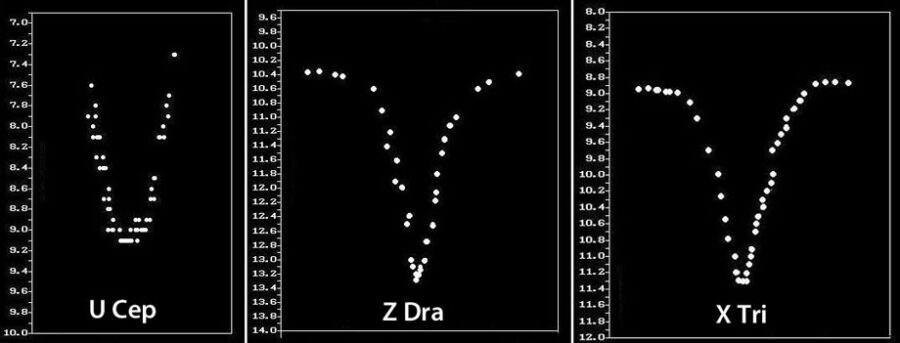
Mike Clarke
Tossing around terms like eclipse and totality reminds us that we're watching true eclipses just like the familiar Sun-Moon variety. That makes it easy to visualize what we're seeing . . . and go further. Imagine the rapidly changing views you'd see from the surface of an exoplanet orbiting one of these systems. Forget about roller coasters. It would feel more like riding a Tilt-A-Whirl. The fastest eclipsing binary is a 20th-magnitude pair of white dwarfs in Boötes designated ZTF J1539+5027. The two tear around their center of gravity every 6.91 minutes and orbit so tightly the entire system would fit inside the globe of Saturn.
More Than One Flavor
Eclipsing binaries come in three basic types determined by the distance between the two stars, as well as a number of subclasses:
EA (Algol type) where the light curve is essentially flat outside of eclipses.
EB (Beta Lyrae type) where the two stars are close enough for mutual gravitation to distort their shapes. Stars are ellipsoids instead of spheres and exchange material in mass flows. Variations in brightness occur between eclipses.
EW (W UMa type) where the stars are in contact or nearly so and share a common envelope of gas. The light curve varies constantly. In EWs the stars are so close they take only a few hours to orbit each other.
Mass transfer can alter the predicted period of an eclipsing binary. Careful timings and brightness estimates done by amateurs can uncover these important astrophysical changes and allow us to witness stellar evolution in months and years instead of eons.
A Critical Resource
To keep track of fast EBs you'll need a finder chart and times when these systems are at minimum light. You'll find that information at TIMAK — TIMing Database at Krakow maintained by Krakow Pedagogical University. Click the link, scroll down to find the variable's constellation, and then click on the star of interest. A screen pops up with information about the binary including its magnitude and the depth of the primary and (any) secondary eclipses. At the top of the page click on the Current Minima link. You'll get a graph showing the evolution of the star's period (called an O-C diagram), and at the bottom of the page a list of times of upcoming primary and secondary minima.
Most secondary eclipses are too shallow to notice, so focus on the primary eclipses. Be aware that the times shown are on the 24-hour clock and specific to your time zone — no conversion needed.

I've listed several awesome eclipsing binaries below along with the times of eclipse minima for the next week or two. Use the Krakow database to find the times of future minima or to create a customized observing list. I recommend that you begin observing about an hour before minimum when these systems start to dim rapidly.
If the range of brightness is 1.5 magnitudes or more you should see changes every 10–15 minutes. Alternatively, you could begin observing at minimum and watch the star recover. Or do both. If you're primarily a deep-sky or planetary observer adding a fast EB to your night is like a splash of hot sauce on scrambled eggs.
Meet Our Stars
Below are a selection of eclipsing binaries I think you'll really enjoy observing. Several of them brighten and fade two magnitudes or more within an hour making it possible to see changes in the system's brightness every 10 minutes. Times are given in Universal Time (UT). Subtract 4 hours for EDT; 5 hours for CDT; 6 hours for MDT; and 7 hours for PDT. To see eclipses beyond the listed dates remember to visit the Krakow site mentioned above. Comparison stars and their magnitudes are indicated to help you track brightness changes. North is up in all maps.
Algol (Beta Persei), EA type, magnitude range from 2.1 to 3.4, reaches minimum every 2.86 days.
Easy to follow with the naked eye. Algol remains near minimum for about 2 hours and takes several hours to fade and to rebrighten. Catch it about two hours before minimum or two hours after minimum for the biggest bang.
Rating: Naked eye
Minima times: September 8 (6:30); September 11 (3:19); September 14 (0:08).
For more Algol minima visit Sky & Telescope's Minima of Algol page (and see the tables published in the magazine from September through April).
Sheliak (Beta Lyrae), EB type, magnitude 3.3 to 4.4. Period: 12.9 days.
Regular, continuous variations with the primary minimum around magnitude 4.4, secondary minimum around 3.8, and a maximum magnitude of 3.3. Very easy to follow with the naked eye thanks to handy comparison stars.
Rating: Naked eye
Minimum: Observed on August 25 (4:00); magnitude 3.6.
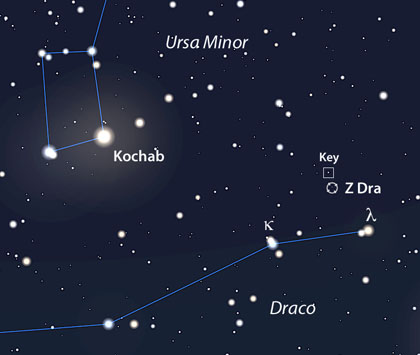
Stellarium
Z Draconis, EA type, magnitude 10.5 to 13.3. Period 1.35 days.
Steep curve with dramatic and continuous brightness changes starting about 1 hour before minimum and continuing until an hour after. Fun to observe!
Rating: 6-inch telescope
Minima: August 27 (0:44); August 31 (2:29)
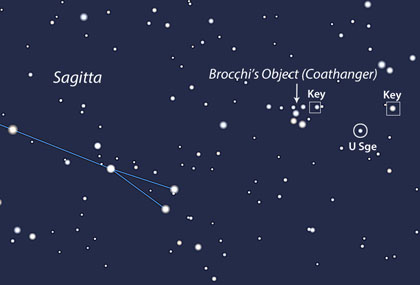
Stellarium
U Sagittae, magnitude 6.5 to 9.3. Period: 3.4 days.
Rapid decline especially ~90 minutes prior to minimum. Minimum lasts about an hour followed by an equally rapid recovery.
Rating: Binoculars or small telescope.
Minima: August 29 (4:23); September 8 (7:47)
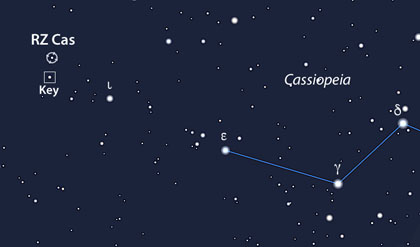
Stellarium
RZ Cassiopeiae, EA type, magnitude 6.2 to 7.7. Period: 1.2 days.
Takes about 90 minutes to fall to minimum, varies slowly for 25 minutes during minimum before climbing steeply again to maximum.
Rating: Binoculars
Minima: September 1 (0:42); September 11 (8:06)
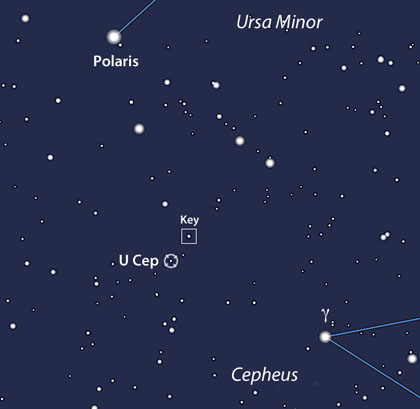
Stellarium
U Cephei, EA type, magnitude 6.8 to 9.2. Period: 2.5 days.
Large magnitude drop during the hour prior to minimum, then steady for two hours at minimum before an equally dramatic rise to maximum.
Rating: Binoculars
Minima: August 27 (6:26); September 1 (6:07); September 6 (5:47)
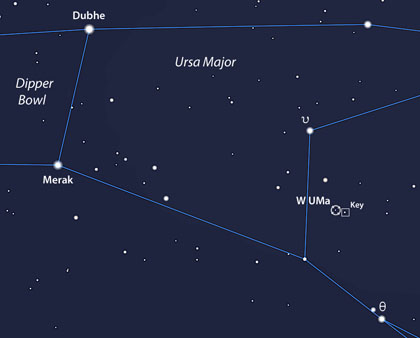
Stellarium
W Ursae Majoris, EW type, magnitude 7.8 to 8.5. Period: 0.3 days (7.9 hours).
Modest magnitude drop but varies continuously, making it a lively showpiece.
Rating: Binoculars, small telescope
Minima: August 26 (2:15); August 26 (6:16)
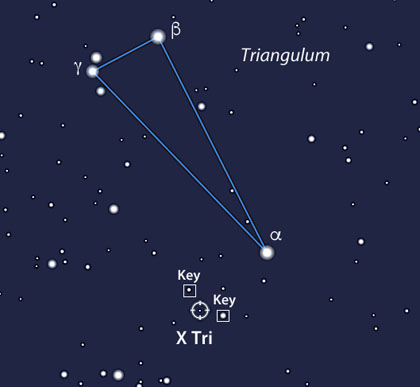
Stellarium
X Trianguli, EA type, magnitude 8.6 to 11.3. Period: 1 day.
Large magnitude range and a steep rise and decline makes this an exciting system to watch.
Rating: 4-inch telescope
Minima: August 26 (4:37); August 27 (3:56); August 28 (3:15)
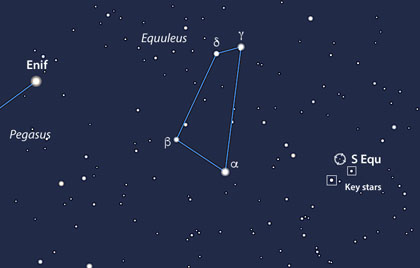
Stellarium
S Equulei, EA type, magnitude 8.4 to 10.4. Period: 3.4 days.
Like several of our featured variables you can watch a dramatic 2-magnitude drop followed by a speedy rise 90 minutes on either side of minimum. I spent an enjoyable hour and a half recently watching its decline and recovery while also observing Mars.
Rating: 3-inch telescope
Minima: September 11 (8:06)
Resources:
BAA Eclipsing Binary Handbook
American Association of Variable Star Observers (charts, recent observations, light curves)
 0
0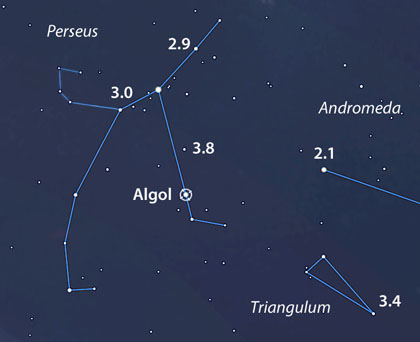
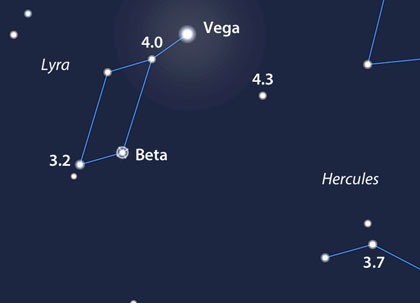










Comments
You must be logged in to post a comment.